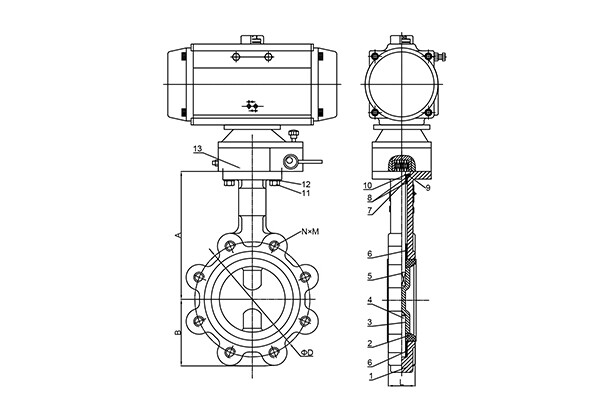
Working Principle of Pneumatic Butterfly Valves:
1. The butterfly valve features a circular disc that rotates with the valve stem, providing shut-off valve action mainly used as stop valves. Additionally, it can be designed with regulating or segmented valve and throttling functions. The use of butterfly valves in low-pressure, large-diameter piping systems is increasing.
2. Butterfly valves are composed of a simple structure, small size, light weight, and few parts. Additionally, they require only 90-degree rotation for quick opening and closing, making operation simple, while possessing good fluid control characteristics. When the butterfly valve is fully open, the thickness of the disc is the sole resistance to the flow of the medium in the valve core, thus resulting in the pressure drop generated by the valve.
3. Due to their small size, they exhibit good flow control characteristics. There are two types of sealing for butterfly valves: resilient and metal sealing. Resilient-seated valves, seal rings can be embedded in the valve body or installed around the periphery of the disc.
If butterfly valves are required for flow control, it is mainly about correctly selecting the size and type of valve. The structural principle of pneumatic butterfly valves is particularly suitable for the production of large-diameter valves. They are widely used not only in general industries such as petroleum, natural gas, chemical, and water treatment but also in cooling water systems of thermal power plants.
Specific Classification of Pneumatic Butterfly Valves:
1. Pneumatic Wafer-Type: Features a novel structure with valve body design meeting short-distance clamp-type structure due to limited space in the pipeline, resulting in zero external leakage and internal leakage that complies with national standards.
2. Pneumatic Lined: Connection methods include flange, clamp, sealing lining with EPDM rubber, EPDM rubber, heat-resistant EPDM rubber, natural rubber, chloroprene, fluororubber, and polytetrafluoroethylene, providing a more reasonable choice based on chemical properties.
3. Pneumatic Lining: Corrosion-resistant fluorine-lined butterfly valves are divided into two-piece valve body combinations, with the valve seat and valve body lining integrated. During valve operation, only the fully formed valve seat and sleeve disc contact the medium, ensuring resistance to corrosion by any medium.
4. Pneumatic Ventilation Butterfly Valves: Featuring a thin gap between the valve plate and seat, suitable for environments with poor air circulation.
Testing and Adjustment of Pneumatic Butterfly Valves:
1. Before leaving the factory, all components of the butterfly valve, whether manual, pneumatic, hydraulic, or electric, undergo strict debugging. When users are rechecking the sealing performance, they should evenly fix both the inlet and outlet sides, close the valve disc, apply pressure to the inlet side, and observe for any leakage on the outlet side. Before conducting a pressure test on the pipeline, the valve disc should be opened to prevent damage to the sealing surfaces.
2. Although pneumatic butterfly valves undergo rigorous inspection and testing before leaving the factory, there may still be individual products whose automatic screws shift during transportation, requiring readjustment. For pneumatic, hydraulic, and other drives, please refer to the instructions provided with the corresponding drive device.
3. Electrically driven butterfly valves leave the factory with the control mechanism's opening and closing strokes already adjusted. To prevent incorrect direction upon power supply connection, after initially powering on, users should manually open the valve to the halfway position and then check if the direction indicated on the indicator matches the valve's closing direction.
Common Faults and Remedies for Pneumatic Butterfly Valves:
1. Before installation, confirm whether the performance of the products from the factory and the direction of the medium flow arrow match the operating conditions. Clean the valve chamber thoroughly, ensuring no impurities or foreign objects on the sealing ring and valve disc. The valve disc should not be closed before cleaning to avoid damaging the sealing ring.
2. For disc installation, it is recommended to use dedicated butterfly valve flanges, such as HGJ54-91 type welding steel flanges.
3.The optimal position for installation in the pipeline is upright, but it should not be installed upside down.
4. For flow adjustment during use, a worm gearbox is used for control.
5. For butterfly valves with frequent opening and closing cycles, approximately every two months, open the worm gearbox cover to check if the grease is normal. Adequate grease should be maintained.
6. Check all connection points to ensure tightness, ensuring both sealing of the packing and flexible rotation of the valve stem.
7. Metal-sealed butterfly valve products are not suitable for installation at the end of pipelines. If they must be installed at the end of a pipeline, an outlet flange should be installed to prevent seal ring accumulation and overtravel.
8. Regularly inspect the valve stem installation and use to assess the valve's effectiveness. Any faults discovered should be promptly addressed.
